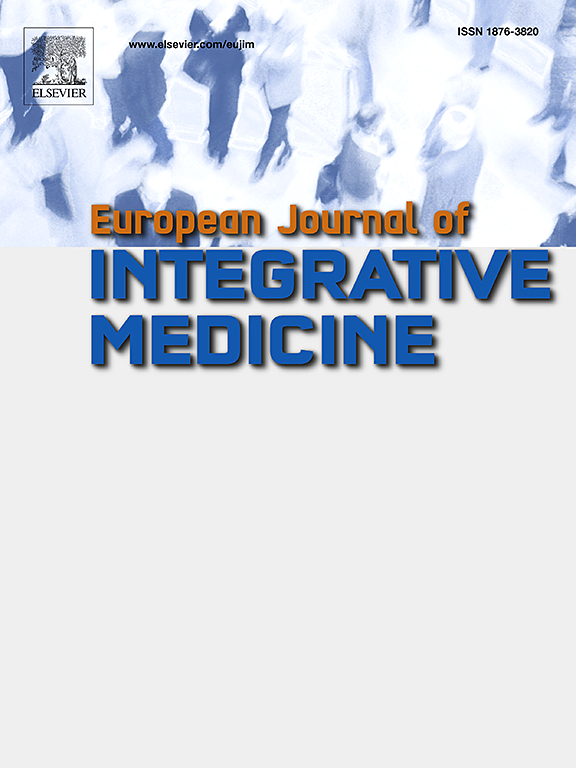伊朗糖尿病患者使用补充和替代药物:一项系统回顾和荟萃分析
IF 1.7
4区 医学
Q3 INTEGRATIVE & COMPLEMENTARY MEDICINE
引用次数: 0
摘要
本研究旨在系统回顾伊朗糖尿病患者使用补充和替代医学(CAM)的文献。方法检索截至2024年8月的国际和伊朗数据库,确定相关研究。在研究选择和数据提取后,采用DerSimonian和Laird随机效应模型对比例进行meta分析。进行亚组分析和敏感性分析,分别探讨异质性来源和评估总体效果的稳健性。结果9项研究中CAM使用的总患病率为62%。异质性非常高(i²(I2) = 99.03%), 95%预测区间范围为14-95%。增加使用辅助治疗可能性的最显著因素是对辅助治疗安全性的积极态度。关于CAM最常见的信息来源是家人和朋友。此外,几乎一半的参与者向他们的医疗保健提供者透露了CAM的使用情况。结论CAM的高使用率和低患者披露率突出了医患沟通的重要性。这一现实使得卫生专业人员必须与患者就其辅助医学的使用进行公开讨论,确保这种做法与传统的糖尿病管理相结合是安全有效的。建议进一步研究所使用的CAM的具体类型及其对治疗成功和患者满意度的影响。本文章由计算机程序翻译,如有差异,请以英文原文为准。
Complementary and alternative medicine use among patients with diabetes mellitus in Iran: A systematic review and meta-analysis
Introduction
This study aimed to systematically review the literature on the use of complementary and alternative medicine (CAM) among patients with diabetes in Iran.
Methods
Relevant studies were identified by searching international and Iranian databases up to August 2024. After study selection and data extraction, meta-analyses of proportions were performed using the DerSimonian and Laird random effects model. Subgroup analysis and sensitivity analysis were conducted to explore the sources of heterogeneity and evaluate the robustness of overall effects, respectively.
Results
The pooled prevalence of CAM use from nine studies was 62%. Heterogeneity was very high (I-squared (I2) = 99.03%) with a wide 95% prediction interval range of 14–95%. The most significant factor increasing the likelihood of CAM use was a positive attitude toward the safety of CAM. The most common sources of information on CAM were family and friends. Additionally, almost half of the participants disclosed the use of CAM to their healthcare provider.
Conclusion
The high prevalence of CAM use, alongside low rates of patient disclosure, underscores the critical importance of physician-patient communication. This reality makes it crucial for health professionals to engage in open discussions with patients about their CAM use, ensuring that such practices are safe and effective in conjunction with conventional diabetes management. Further research is recommended to explore the specific types of CAM utilized and their impacts on treatment success, and patient satisfaction.
求助全文
通过发布文献求助,成功后即可免费获取论文全文。
去求助
来源期刊

European Journal of Integrative Medicine
INTEGRATIVE & COMPLEMENTARY MEDICINE-
CiteScore
4.70
自引率
4.00%
发文量
102
审稿时长
33 days
期刊介绍:
The European Journal of Integrative Medicine (EuJIM) considers manuscripts from a wide range of complementary and integrative health care disciplines, with a particular focus on whole systems approaches, public health, self management and traditional medical systems. The journal strives to connect conventional medicine and evidence based complementary medicine. We encourage submissions reporting research with relevance for integrative clinical practice and interprofessional education.
EuJIM aims to be of interest to both conventional and integrative audiences, including healthcare practitioners, researchers, health care organisations, educationalists, and all those who seek objective and critical information on integrative medicine. To achieve this aim EuJIM provides an innovative international and interdisciplinary platform linking researchers and clinicians.
The journal focuses primarily on original research articles including systematic reviews, randomized controlled trials, other clinical studies, qualitative, observational and epidemiological studies. In addition we welcome short reviews, opinion articles and contributions relating to health services and policy, health economics and psychology.
 求助内容:
求助内容: 应助结果提醒方式:
应助结果提醒方式:


